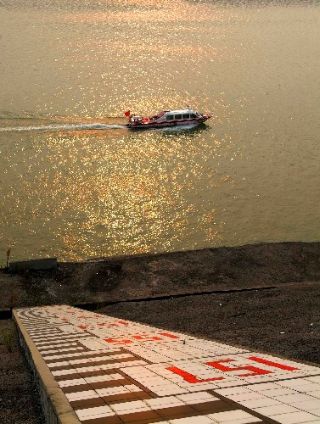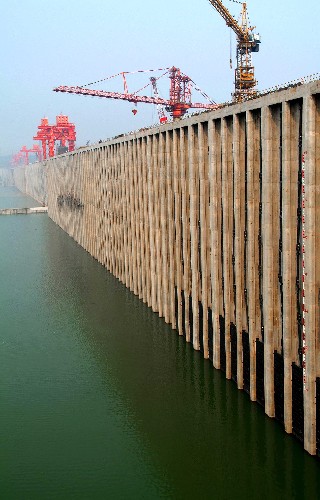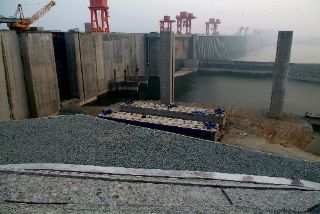| Tools: Save | Print | E-mail | Most Read |
| Three Gorges Water Level Raised to 156 Meters |
| Adjust font size: |
The second phase of raising the Three Gorges Reservoir's water level to 156 meters began at 10:00 PM on Wednesday, with the procedure aiming for completion by mid-October. One of the 13 power-producing generators was shut down, reducing electricity generation to 5.65 million kw, down from 6.86 million kw, according to Li Yong'an, general manager of the China Yangtze River Three Gorges Project Development Corporation. By midnight, the water level in the Three Gorges Reservoir will have risen by 0.6 meters. The level is estimated to reach 156 meters in mid-October, which would be a milestone in the construction of the Three Gorges Project. Earlier in the day, Chongqing municipality, upstream from the reservoir, launched a massive clean-up campaign to prevent water-fouling. The timing of the second phase had been approved by the State Flood Control and Drought Relief Headquarters (SFCDRH), said Cao Guangjing, deputy general manager of the corporation. SFCDRH has limited the raising of the water level to a maximum of five meters per day with the volume of water discharged downstream limited to 8,000-10,000 cubic meters per second so as to prevent affecting anti-drought efforts and water usage in downstream areas. The second phase is one of the most important stages in the Three Gorges Project on the middle reaches of China's longest river, the Yangtze. When the water level reaches 156 meters, the project will increase power production by 7.85 billion kw/hours annually, while water storage will rise by 11 billion cubic meters, improving shipping conditions upstream. The reservoir currently holds 14 billion cubic meters of water. The water level will rise from the current 135 meters to 148 meters by October 1 and then to 156 meters by mid-October after a two-day break during which engineers can monitor the effects on the dam, which was completed in May. Traffic in the dam area has had to be restricted to one direction, alternating every 24 hours, since September 15 when work began on a year-long project to raise the beds of the two topmost tiers of the ship lock from 131 to 139 meters. This will ensure safe navigation when the water level behind the dam rises to 156 and finally to 175 meters. The first rise from the natural flow of the Yangtze to 135 meters began on June 1, 2003, when the reservoir was formed. Meanwhile, Chongqing, the largest industrial city in the Three Gorges area, began a clean-up campaign with a budget of 4.6 million yuan (US$575,000). The areas of nine counties and districts in the municipality will be inundated when the water level rises to 156 meters. Six hundred workers, with 208 boats and 58 motor vehicles, have been mobilized to clear the affected areas and the Yangtze's 20 dried-up lesser tributaries of tree branches, solid waste and farm debris, said Tang Jiali, deputy director of Chongqing Municipal Environmental Hygiene Bureau. "If this rubbish is not cleared, it will be washed down into the reservoir, polluting the environment and endangering shipping." About 1.16 million people have been relocated since construction on the project began in 1993. The 185-meter dam spans 2,309 meters, housing 26 power generators on banks, and a five-tier, dual-track ship lock. The anticipated level of 156 meters resettled 244,500 people from 13 districts and counties at a cost of 10.27 billion yuan. By April, 126 billion yuan (US$15.75 billion) had been spent on construction of the Three Gorges project. A total of 130 billion kw/h of electricity has been generated since July 2003, earning 25 billion yuan (US$3.125 billion) in revenue.
(Xinhua News Agency September 21, 2006) |
| Tools: Save | Print | E-mail | Most Read |
 |
| Related Stories |
| Product Directory China Search |
Country Search Hot Buys |


